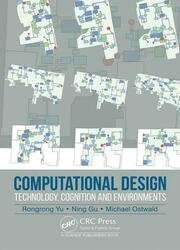Computational Design: Technology, Cognition and Environments
- Добавил: literator
- Дата: 24-06-2021, 16:53
- Комментариев: 0
 Название: Computational Design: Technology, Cognition and Environments
Название: Computational Design: Technology, Cognition and EnvironmentsАвтор: Rongrong Yu, Ning Gu, Michael J. Ostwald
Издательство: CRC Press
Год: 2021
Страниц: 253
Язык: английский
Формат: pdf (true)
Размер: 10.1 MB
An essential guide for teaching and learning computational art and design: exercises, assignments, interviews, and more than 170 illustrations of creative work.
There are two common ways of understanding the field of ‘computational design’. First, it can be defined as a systematic way of thinking about or conceptualising the design process. This could be understood as a rigorous reasoning method founded in the timeless fields of mathematics and logic. The second definition of computational design encapsulates the hardware, software and systems that support the act of designing. These have developed rapidly over time to respond to the needs of designers. The scope of this book encompasses both of these definitions of computational design, as well as the overlap or interdependency between them. This is a particularly interesting way of approaching the topic of computational design, because it emphasises the interactions between a seemingly stable body of knowledge on the one hand, and an increasingly dynamic technological environment on the other.
Three distinct aspects of computational design are introduced and explored in this book: design technology, design thinking and design environments. The first is associated with the hardware, software and systems used to support design, and which might in turn shape the way designers work and think. The second is concerned with the cognitive mental processes that occur during acts of designing, and which are influenced by computational design technologies. The third explores a variety of coexisting computational environments and contexts that are available to designers. This book does not, however, completely separate these three. Instead, it examines the connections between them, gradually building up a picture - literally a multi-stage figure and conceptual model – which explains how they shape one another.
Contents:
Скачать Computational Design: Technology, Cognition and Environments
Внимание
Уважаемый посетитель, Вы зашли на сайт как незарегистрированный пользователь.
Мы рекомендуем Вам зарегистрироваться либо войти на сайт под своим именем.
Уважаемый посетитель, Вы зашли на сайт как незарегистрированный пользователь.
Мы рекомендуем Вам зарегистрироваться либо войти на сайт под своим именем.
Информация
Посетители, находящиеся в группе Гости, не могут оставлять комментарии к данной публикации.
Посетители, находящиеся в группе Гости, не могут оставлять комментарии к данной публикации.

